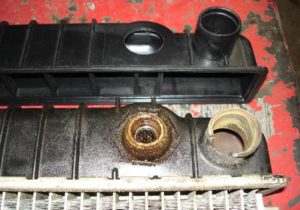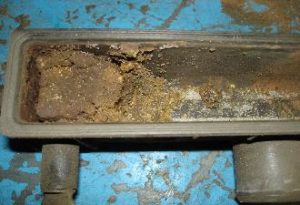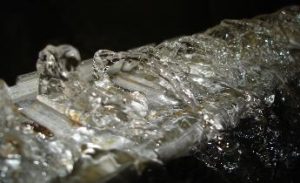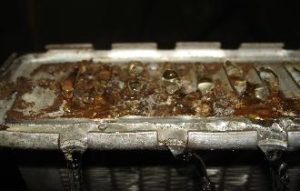PLASTIC RADIATOR REPAIR
Here is a common problem on nearly any car built since about 1990. Radiators are now built out of aluminum and plastic instead of copper and brass. While the aluminum design gives longer life, and better cooling, there are also some major disadvantages. The main disadvantage of building a radiator out of plastic is that over time, plastic will become brittle and break. A radiator is subjected to major extremes of temperature. A radiator can be subjected to temperature swings from 0 degrees or lower depending on outside temperature, to 240 degrees or more as scalding hot antifreeze comes out of the engine at 40 gallons per minute. When you consider the millions of gallons of coolant that circluates through a radiator during its life, it is truly amazing that a radiator lives as long as it does. The major problem with a plastic tank radiator is a failure of the plastic, usually in the area directly by the inlet neck. This is where the hottest coolant fluid hits the plastic, and over time, the stresses of extreme temperatures take its toll and the plastic tank will develop a leak.
Kendrick Radiator has a solution to this problem. Instead of throwing your radiator away and buying a new one, we simply remove the broken plastic tank, and install a new one. We don’t use and magic glue, super adhesive, or bondo, (although we have seen many people try to fix them this way). A brand new Factory plastic tank installed by Kendrick Radiator will give you many more years of trouble free service.
The following pictures illustrate a problem and then the cure by Kendrick Radiator.

Problem – Broken neck on a plastic radiator tank. A customer was replacing a radiator hose at home and overtightened the top radiator hose. In its brittle state, the tank broke and he had a leak. On the bottom is the original radiator with a chunk missing out of the inlet neck on the radiator.
On the top is a brand new GM Factory radiator tank that we will install on this radiator. We will remove the broken plastic tank from the radiator.
Then, we remove the oil cooler from the old tank and replace it in the new tank with new gaskets to prevent any leaks. While we have the radiator disassembled, we will clean out the tubes inside the radiator and check the flow. Next we reinstall the new radiator tank with a new gasket. The last step is to bench the radiator under pressure to double check that there are no leaks. Problem solved with service from Kendrick Radiator.

Here is another common problem we see with many cars today. Major contamination in the cooling system. This can be caused by many different things including: General neglect of anti-freeze, rust in the cooling system from the engine, mixing the wrong type of anti-freeze, adding stop leaks to the radiator, etc. This radiator did not leak, it just severely overheated, leaving the customer stranded on the side of the road. The solution is to remove the plastic tank and remove all contamination from the radiator. The pictures below will show the difference in flow rates before and after cleaning.


Water flow through radiator before cleaning by Kendrick
Water flow through radiator after cleaning by Kendrick
These two pictures show the major change in coolant flow of a radiator before and after it has been cleaned by Kendrick Radiator. To simulate coolant flow through the radiator we have attached a water line to the radiator and let the water flow through it. The radiator on the left has not been cleaned, and the water just barely trickles through it. Low coolant flow through a radiator will not dissipate the heat quickly enough and cause a serious overheating situation. The picture on the right is the same radiator after it has been cleaned out and is ready to be reassembled. As you can see, the water is practically jumping out of the radiator. This higher flow rate will allow coolant to flow through the engine faster, which makes for a more efficient transfer of heat to the radiator. This will keep the engine at the proper operating temperature. Another, cooling system problem solved by Kendrick Radiator.
